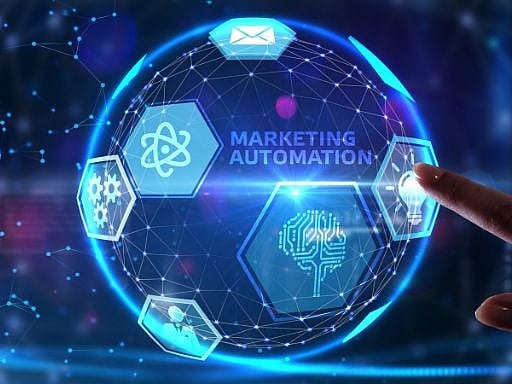Main Links

Last Updated February 20, 2023
 Marketing automation is a powerful tool for businesses of all sizes to maximize their marketing efforts. It is a set of technologies that help automate various marketing tasks, such as customer segmentation, campaign development, email, and social media campaigns, and lead generation.
By leveraging automation, businesses can target the right customers with the right messages at the right time, resulting in increased efficiency and better customer engagement. Additionally, marketing automation best practices can help ensure that businesses are making the most of their efforts and maximizing their return on investment.
Marketing automation best practices can help businesses maximize their marketing efforts and get the maximum return on their investment. Automation can help streamline and optimize the marketing process, allowing businesses to create more effective and targeted campaigns and reach a wider audience.
Automation can also help reduce manual labor and free up time for more strategic tasks. With marketing automation, businesses can reach more potential customers, build stronger relationships, and drive more revenue.
Marketing automation is a powerful tool for businesses of all sizes to maximize their marketing efforts. It is a set of technologies that help automate various marketing tasks, such as customer segmentation, campaign development, email, and social media campaigns, and lead generation.
By leveraging automation, businesses can target the right customers with the right messages at the right time, resulting in increased efficiency and better customer engagement. Additionally, marketing automation best practices can help ensure that businesses are making the most of their efforts and maximizing their return on investment.
Marketing automation best practices can help businesses maximize their marketing efforts and get the maximum return on their investment. Automation can help streamline and optimize the marketing process, allowing businesses to create more effective and targeted campaigns and reach a wider audience.
Automation can also help reduce manual labor and free up time for more strategic tasks. With marketing automation, businesses can reach more potential customers, build stronger relationships, and drive more revenue.
 If you're looking to streamline your marketing efforts, then marketing automation is the way to go. With automation, businesses can quickly and efficiently reach out to potential customers, track their engagement with campaigns and monitor the success of their efforts.
Automation also allows businesses to target specific audiences and send out personalized messages that are more likely to be successful. With automated marketing, businesses can save time and resources while maximizing their efforts.
1. Increased Efficiency – Automation reduces the amount of manual labor associated with running campaigns, such as creating emails or updating customer records. This saves time and resources, allowing businesses to focus on other areas.
2. Improved Targeting – With automation, businesses can segment their customer base into specific groups, which allows them to target specific audiences with tailored messages. This can also help businesses save money as they only send out relevant messages.
3. Improved Insights – Automation also allows businesses to gain useful insights into the success of their campaigns. With automated tracking, businesses can quickly assess the effectiveness of their efforts, allowing them to make any necessary changes.
4. Automated Follow-Ups – Automation also makes it easier for businesses to follow up with leads and customers. Automated messages can be set up to ensure that customers don’t forget about a business and its products or services.
5. Cost Savings – Automation can help businesses save money as they can automate tasks that would normally require manual labor. This allows businesses to save on labor costs and focus their resources on other areas.
If you're looking to streamline your marketing efforts, then marketing automation is the way to go. With automation, businesses can quickly and efficiently reach out to potential customers, track their engagement with campaigns and monitor the success of their efforts.
Automation also allows businesses to target specific audiences and send out personalized messages that are more likely to be successful. With automated marketing, businesses can save time and resources while maximizing their efforts.
1. Increased Efficiency – Automation reduces the amount of manual labor associated with running campaigns, such as creating emails or updating customer records. This saves time and resources, allowing businesses to focus on other areas.
2. Improved Targeting – With automation, businesses can segment their customer base into specific groups, which allows them to target specific audiences with tailored messages. This can also help businesses save money as they only send out relevant messages.
3. Improved Insights – Automation also allows businesses to gain useful insights into the success of their campaigns. With automated tracking, businesses can quickly assess the effectiveness of their efforts, allowing them to make any necessary changes.
4. Automated Follow-Ups – Automation also makes it easier for businesses to follow up with leads and customers. Automated messages can be set up to ensure that customers don’t forget about a business and its products or services.
5. Cost Savings – Automation can help businesses save money as they can automate tasks that would normally require manual labor. This allows businesses to save on labor costs and focus their resources on other areas.
 Creating buyer personas is a key step in implementing successful marketing automation best practices. Buyer personas are detailed descriptions of a target audience that helps you understand their needs, preferences and motivations.
This helps you tailor your marketing automation efforts to the right audiences and ensure your efforts are as effective as possible. Ensure optimal results by crafting vivid buyer personas and harnessing them as a basis for all of your marketing automation campaigns.
Creating these segments will help you tailor each piece of communication to specific needs and make the most impactful presence possible! Once you've crafted the buyer personas, leverage them to guide your marketing automation efforts in a meaningful way.
Leverage the buyer personas to craft tailored messaging that resonates with the target audience. Use the buyer personas to create segmented lists based on different characteristics, such as age, location, interests, etc.
This will help you personalize your campaigns to better serve each customer segment. Additionally, use the buyer personas to inform the channels and tactics used in your marketing automation campaigns.
For example, if you have identified a particular persona that prefers email communication, focus on creating email campaigns for that persona. Similarly, for a persona that is more likely to engage on social media, focus your efforts on creating social media campaigns tailored to that persona.
Creating detailed buyer personas is a crucial step in successful marketing automation. By leveraging the insights from the buyer personas, you can create campaigns that are tailored to the needs and preferences of the target audience, resulting in higher engagement and conversion rates.
Creating buyer personas is a key step in implementing successful marketing automation best practices. Buyer personas are detailed descriptions of a target audience that helps you understand their needs, preferences and motivations.
This helps you tailor your marketing automation efforts to the right audiences and ensure your efforts are as effective as possible. Ensure optimal results by crafting vivid buyer personas and harnessing them as a basis for all of your marketing automation campaigns.
Creating these segments will help you tailor each piece of communication to specific needs and make the most impactful presence possible! Once you've crafted the buyer personas, leverage them to guide your marketing automation efforts in a meaningful way.
Leverage the buyer personas to craft tailored messaging that resonates with the target audience. Use the buyer personas to create segmented lists based on different characteristics, such as age, location, interests, etc.
This will help you personalize your campaigns to better serve each customer segment. Additionally, use the buyer personas to inform the channels and tactics used in your marketing automation campaigns.
For example, if you have identified a particular persona that prefers email communication, focus on creating email campaigns for that persona. Similarly, for a persona that is more likely to engage on social media, focus your efforts on creating social media campaigns tailored to that persona.
Creating detailed buyer personas is a crucial step in successful marketing automation. By leveraging the insights from the buyer personas, you can create campaigns that are tailored to the needs and preferences of the target audience, resulting in higher engagement and conversion rates.
 When it comes to implementing a successful marketing automation strategy, having a well-prepared content strategy is key. It's important to plan out your content ahead of time and create a plan for how you will engage with your customers.
Think about what type of content your customers would be most interested in, as well as how often you will be able to provide them with new content. This will help ensure that your marketing automation efforts are successful.
Creating a content strategy is an essential part of any successful marketing automation effort. It ensures that all content is relevant to your target audience, and helps you to create a consistent voice for your brand.
When building a content strategy, you should think about what kind of content you want to create. What topics and keywords will you be focusing on? What type of content will be most relevant and engaging for your audience? It’s also important to consider.
Once you have a good idea of what type of content you want to create, you can start planning it out. Create an editorial calendar that outlines when you will be releasing new content.
Consider what elements you will include in each piece of content, such as images, videos, and interactive elements. You should also develop a plan for how you will promote your content. Will you be using paid advertisements or organic methods such as SEO and social media?
Finally, be sure to track and measure the success of your content strategy. Monitor how your content performs and make adjustments as needed. This will help you to ensure that your content is reaching the right people and engaging them in meaningful ways.
When it comes to implementing a successful marketing automation strategy, having a well-prepared content strategy is key. It's important to plan out your content ahead of time and create a plan for how you will engage with your customers.
Think about what type of content your customers would be most interested in, as well as how often you will be able to provide them with new content. This will help ensure that your marketing automation efforts are successful.
Creating a content strategy is an essential part of any successful marketing automation effort. It ensures that all content is relevant to your target audience, and helps you to create a consistent voice for your brand.
When building a content strategy, you should think about what kind of content you want to create. What topics and keywords will you be focusing on? What type of content will be most relevant and engaging for your audience? It’s also important to consider.
Once you have a good idea of what type of content you want to create, you can start planning it out. Create an editorial calendar that outlines when you will be releasing new content.
Consider what elements you will include in each piece of content, such as images, videos, and interactive elements. You should also develop a plan for how you will promote your content. Will you be using paid advertisements or organic methods such as SEO and social media?
Finally, be sure to track and measure the success of your content strategy. Monitor how your content performs and make adjustments as needed. This will help you to ensure that your content is reaching the right people and engaging them in meaningful ways.
 Social media advertising automation is one of the most powerful marketing automation best practices today. With automation, businesses can create and promote campaigns quickly and efficiently across multiple social media platforms, allowing them to reach their desired audience with ease.
Automation also enables businesses to track their campaigns in real-time, helping them adjust their strategies accordingly for maximum success. Automated campaigns allow businesses to quickly create, schedule, and distribute content across multiple social media platforms in a timely manner.
Additionally, businesses can use automation to target specific audiences based on their interests and demographics, helping them ensure their campaigns reach the right people. Automation also reduces the amount of manual work required to run campaigns, saving businesses time and money.
Finally, automation can be used to measure the success of campaigns, providing businesses with valuable insights on how to improve their strategies in the future.
Social media advertising automation is one of the most powerful marketing automation best practices today. With automation, businesses can create and promote campaigns quickly and efficiently across multiple social media platforms, allowing them to reach their desired audience with ease.
Automation also enables businesses to track their campaigns in real-time, helping them adjust their strategies accordingly for maximum success. Automated campaigns allow businesses to quickly create, schedule, and distribute content across multiple social media platforms in a timely manner.
Additionally, businesses can use automation to target specific audiences based on their interests and demographics, helping them ensure their campaigns reach the right people. Automation also reduces the amount of manual work required to run campaigns, saving businesses time and money.
Finally, automation can be used to measure the success of campaigns, providing businesses with valuable insights on how to improve their strategies in the future.